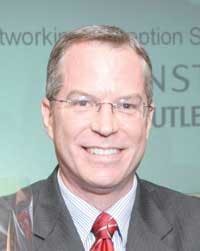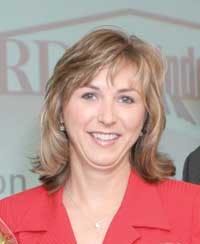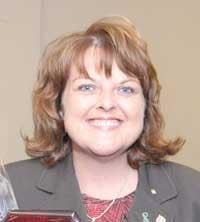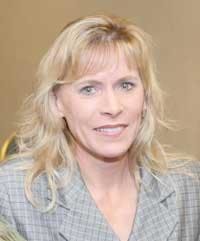2005 Sunstar Butler GUM/RDH Healthy Gums, Healthy Smiles Award of Distinction
In July, at the RDH Under One Roof Conference eight exceptional dental hygienists were the recipients of the 2005 Sunstar Butler GUM®/RDH Healthy Gums, Healthy Smiles Award of Distinction. The recipients were formally recognized during a ceremony at the elegant Palmer House Hilton in beautiful Chicago, Ill. The eight awardees previously submitted essays to RDH Magazine about the differences they make in helping patients enjoy healthier lives, sharing their techniques to ensure patient compliance with their treatment strategies, and explaining how they serve their local community through volunteer efforts. The excitement in the air was palpable as hygienists from all over the country gathered to learn, share, and reunite with old friends and classmates, as well meet the eight outstanding award winners.
Maureen Murphy Chodaba, RDH
Highland, New York
Personal motto: “Be a comfortable person ... Be an old shoe, old hat kind of individual.”
Maureen Murphy Chodaba believes in helping patients by fitting in with them and reaching them at their own level. “Being someone who is comfortable, genuine, and easy to be with” is her down-to-earth strategy. She has enjoyed 28 years of full-time hygiene practice, loving it all, even when facing severe personal health challenges.
Dental hygiene is a healing profession, but Maureen says her patients also heal her. When diagnosed with breast cancer in 1995, Maureen worked full time even through her chemotherapy. “When I was ill, I truly realized that the healing capabilities of our profession are actually double-edged. The wonderful relationships I have developed with my patients helped to heal me in ways I cannot describe.” As a 10-year cancer survivor, Maureen volunteers and helps in fundraisers for the American Cancer Society’s Reach to Recovery support system, Miles of Hope Breast Cancer Foundation in the Hudson Valley, the “Look Good, Feel Better” cancer cosmetic support program, Susan G. Komen “Race for the Cure,” and “Relay For Life.” “Through all my volunteer activities, I always identify myself as a registered dental hygienist! I feel it is important for everyone to really know what a dental hygienist is, what we do, and what we stand for!” A strong advocate of professional associations, she is a member of ADHA and her state and local component.
Catherine Kelly Draper, RDH
San Jose, California
Personal motto: “Live each day to the fullest.”
It seems like Cathy Kelly Draper is able to pack more activity and purpose into a day than most people. As a personalized resource professional, she makes each day count with her patients and the general public by being on top of all the latest health information. Her volunteer position as a library reference associate at the Stanford Hospital Health Library puts her in contact with people researching health-related questions so they can make educated and informed choices about their health care. “I enjoy being able to use my health-care background to assist the public in making educated decisions regarding their health care. I also know from personal experience how stressful and overwhelming the hospital experience can be. In 1992 when my eldest son was in renal failure, I was able to donate my kidney to him. He is now a healthy 24-year-old, thanks to his kidney transplant.”
Cathy appeared in a 30-second PSA for the Health Library stressing the importance of health education and informed decision-making that ran on local TV for over a year. A practicing RDH for 30 years, she has worked in Croatia and Germany as part of an exciting career. In 2001, she led a “People to People” delegation of dental hygienists to China. Recently she began teaching CE courses on implant therapy and high-tech hygiene. She is a past president of the California Dental Hygienists’ Association. She continues to be active in her local component as the SADHA liaison as well as being the new technologies council chair for CDHA, and still has time to be a wife and mom to four sons.
Noel Kelsch, RDH
Moorpark, California
Personal mottos: “Life is not so much about what happens to you; it is more about how you decide to react to what happens to you.” “Life’s uncertain, eat dessert first.” “Strive.”
“The best part of my job is I get to cradle people in my lap all day. I touch people and their spirits in an intimate way that few other people are granted. While I am there, I get the privilege of learning, growing, and making their smile just a little brighter and their health a little better. Who could ask for more?” says Noel Kelsch. Noel is also a freelance dental hygiene cartoonist, which allows her to combine her love of hygiene, humor, and art. She graduated from Cabrillo College in 1992 after a first career in early childhood education. “I have worked in a variety of settings, from public health, comics, and perio. I love the variety this career affords us all. Cleaning teeth is the smallest part of the job we do.”
She is active in her local component and volunteers for many organizations, from foster parenting to the American Cancer Society to National Make a Difference Day. She has developed a program called “Hugs from Home” that creates and distributes hand-crocheted scarves and hats for homeless youth. “This past year I spent a long time in bed recovering from foot surgery. I’ve had the opportunity to make 1,577 scarves this year to date.”
Beth McKinney, RDH
Washington, D.C.
Personal mottos: “Get an education; it’s the one thing no one can take away from you” (from my dad). “Happiness is a habit: cultivate it” (from my grandmother).
As a public health dental hygienist for 18 years, Beth McKinney sees patients who are often poor, pregnant, and/or don’t speak English. “For some, I am their first dental experience,” she writes. “I also work with other health-care professionals to raise the standard of health among our clients. I work with dentists and school nurses to see that abscessed teeth are promptly treated. I work with nurse case managers to facilitate treatment in high-risk pregnancies. I work with social workers to help ensure that patients make it to their appointments.”
Beth says being in public health keeps her enthusiasm high for her hygiene career. “I think it’s the variety. It’s almost impossible to get burned out, and I’m rewarded every day by truly needy people who are very grateful for the services.”
Beth is involved in her community by being a part of the health ministries committee at her church, teaching oral health classes to mentally challenged young adults and parents of health-challenged children, volunteering for cancer screenings and health fair activities, mentoring student dental hygiene interns from the University of Maryland, and providing foster home care for abandoned/stray cats.
Beth’s Marine Corps husband won a bronze star for his service in Iraq. “I think he still holds the record for the family.”
Editor’s note: Due to illness, Ms. McKinney was unable to attend the award ceremony, if readers are wondering why she does not appear in this article’s photographs.
C. Austin Risbeck, RDH
San Leandro, California
Personal motto: “Always strive for excellence, not perfection.”
Austin Risbeck has expanded his role as a dental hygienist to help other health professionals with the responsibility of achieving and maintaining the total health of the public. He includes tobacco cessation, dietary guidance, and oral cancer screenings, just to name a few, as part of comprehensive care to his patients. “I refer as appropriate,” he writes. “I use evidence-based tobacco cessation techniques and dietary recommendations that will not only help reduce the incidence of dental caries, oral cancer, and periodontal disease, but will reduce risk for heart disease, obesity, type 2 diabetes, high blood pressure, osteoporosis, and certain cancers.”
Since 2003, Austin has been providing education materials to hygienists so they can teach the connection between oral and systemic health to their patients. He serves on the Public Health Council for both the American Dental Hygienists’ Association and the California Dental Hygienists’ Association. He helped design and provide the Web content for ADHA’s Ask. Advise. Refer. Web site, and he also designed CDHA’s public health Web site which includes tobacco cessation, nutrition, diabetes, oral cancer, and blood pressure control resources for the dental hygienist.
Austin volunteered to serve his community through celebrating National 5 A Day Month in September 2004. “I coordinated a group of dental hygienists and hygiene students at a local grocery store to encourage low-income children and their parents to eat at least five servings of fruits and vegetables a day, and to be active everyday.”
Cappy Snider, RDH
Azle, Texas
Personal motto: “Beauty is in the details.”
Cappy Snider can be counted on to dot the “i” in every project she’s ever taken on; no detail is too detailed! This also carries over into her 18-year practice of dental hygiene where keeping up with the latest oral research is paramount. “To help my patients lead healthier lives, I closely monitor their periodontal health and inform them of my findings,” she writes. “I genuinely care for their health by treating them with respect and constructively suggesting behavior changes, not lecturing them on why they are bad!” She enjoys those “lightbulb moments” when patients benefit from the information she has given them.
Besides a passionate pursuit of her faith, reading, cooking, and her love for her husband and two children, Cappy works with elementary school students and administration about oral health topics such as soda consumption and oral health care. She recently spoke about the wonders of spit, which was popular with the boys, “until I told them that spit works best when kept inside their mouth.” Cappy credits her mentors - Anne Guignon and her employer, Dr. Brooke Porter - as well as most of the RDHs on Amy’s dental hygiene email list. She says she keeps her enthusiasm high by staying involved with others who are also enthused about hygiene.
Cheryl Thomas, RDH
Galveston, Texas
Personal motto: “Carpe diem!”
Seizing the day is evident in Cheryl Thomas’ personal and professional life. She helps her patients make the oral health/overall health connection through thorough medical health review, discovering what patients will embrace for their oral-care routines, and being enthusiastic and positive about oral health. She also educates dental professionals about pre- and post-organ transplant issues. “My goal is to share my dental education/experience to help these patients avoid life-threatening infections.” A renal transplant recipient in 1999, Cheryl has made organ donor advocacy her inspiration and passion. “We named my new kidney ‘Kinney,’ and it is my pride and joy,” she writes. “I am so lucky to have this second chance at life!” Cheryl has been a volunteer and speaker for the Southwest Transplant Alliance for three years and shares both dental and transplant knowledge with organ donor candidates, organ donor recipients, and others. “It is an active way I can give back to the community,” she says.
A 12-year veteran of dental hygiene and 12-year member of the ADHA, four years ago she started her own writing and speaking business that she calls “Dental Inspirations.” She has been the wife of Richard for 20 years. “Winning this award has meant the world to me. Every hygienist deserves recognition for the time and passion we invest in our careers. I feel very fortunate to be among the recipients this year.”
Maxine Wehling, RDH
Broken Bow, Nebraska
Personal motto: “I believe it is worthy to look for the good characteristics in all people.”
Healthy lifestyles are important to Maxine Wehling. She offers much information to her patients about all aspects of health care, not just dentistry. Graduating from the Central Community College Dental Hygiene Program in Hastings, Neb., in 1996, she says, “I have been blessed to have practiced dental hygiene in offices that believe in utilizing my clinical experience to impact patients’ lives fully. I am passionate about having motivated clinicians discuss C-reactive protein levels, bone density screenings, diabetes evaluation, and the systemic correlation of periodontal disease with their patients.”
Maxine also pampers her patients to make dental hygiene visits more pleasant and relaxing by offering paraffin hand treatments, back massage units in the dental chair, flavored lip balms, and scented aromatherapy guest towels. She encourages colleagues to invest in their own dental hygiene equipment so they can offer patients the latest therapies.
Maxine’s community service includes cable and radio educational programs to promote National Dental Hygiene month and Children’s Dental Health month, discussing access-to-care issues with local health officials, as well as organizing oral and skin cancer screenings at a local health fair. Her husband of 16 years, whom she describes as “an awesome supporter of the dental hygiene profession,” heads up construction of her yearly oral cancer screening booth.
Cathleen Terhune Alty, RDH, a frequent contributor to RDH, is based in Clarkston, Mich.
Tips for improving patient compliance
Maureen Chodaba ...
1. When communicating one on one, be an “old shoe” - someone who is comfortable, genuine, and easy to be with. Do not intimidate.
2. Take your time. Answer questions. Ask questions about their life and schedule.
3. Talk about your own life … your everyday schedule. Tell them what you do … what time or times of the day you floss, when you brush, etc. Relate to them!
4. Smile! You are a dental hygienist! Show your teeth! Look into their eyes when you speak … don’t just look at their teeth.
5. Take an interest in your patient as a whole person, not just a set of teeth.
Tips for improving patient compliance
Catherine Draper ...
1. Treat your patients as you would want to be treated.
2. Be a good listener/observer starting from the moment you bring them into your operatory. Body language often speaks louder than words. If your patient is anxious or stressed, try to determine the cause of the problem before you begin to treat them.
3. Don’t “lecture” your patients. I like to tell my patients to think of me as their personal trainer for their oral health. I want to work with them to set goals that are achievable.
4. Problem solve your patients’ oral health issues together. Give your patients options regarding their oral health and let them tell you what will work for them.
5. Utilize your patient’s X-rays, intraoral photographs, perio charts, and models to personalize your home-care instructions to meet your patient’s needs. Provide your patients with copies of their perio chart and have handouts available to reinforce your verbal information.
Tips for improving patient compliance
Noel Kelsch ...
1. Put yourself in relationship with your patients. Take the time to find out who they are and what their needs are. You can do this simply by looking at their occupation, their health history, etc. You will get many clues when they answer simple questions. When a patient answers, “My spouse sent me,” it opens the door to understanding, motivation, and needs.
2. Patients’ special needs should be on the health history. Ask the patient if there is anything that you can do to make them more comfortable. This small question can make a world of difference. One patient told me that she hates to be polished, and it was the primary reason why she had not visited us for two years. I explained to her about selective polishing and that polishing was not necessary. Simply offering a warm pillow to a patient who, according to health history, has back pain will change his or her visit completely. When patients see and know that you care about them individually, they are more likely to comply.
3. Take the time to explain periodontal and hard tissue disease of the mouth. It is amazing how many people really do not know. Once a person has an understanding of why we are doing what we are doing, they are more likely to comply. Do this in a manner the patient can relate to. For a carpenter, I explain that, with advanced periodontal disease, the tooth is like a fence post set in dirt instead of cement. Give the patient up-to-date information about xylitol, for example, or other resources he or she can investigate further.
4. It is not enough to simply motivate the patient; you must help them take responsibility for their oral/full body health. I explain that the largest role in arresting this disease lies in the patient’s hands. In educating the patient, you are giving them the opportunity to use the tools to treat the disease. Allow them to make the choice between these “tools.” Patients who simply refuse to floss change their minds completely when they see a floss holder that fits in their pocket and their lifestyle.
5. Stay updated! I love it when patients ask about a TV commercial or newspaper article. This motivates me to take the time to research the facts. As hygienists, we have a wealth of information available to us. Use the Web, journals, and CE classes. Have pride in your profession. Offer cutting-edge information that can help change patients’ lives and overall health.
Tips for improving patient compliance
Beth McKinney ...
1. Develop cultural competence. We need to be sensitive to cultural nuances when educating and treating patients, or our efforts will not be successful. Did you know that toothbrushes and floss may be totally unfamiliar to some people from Africa where they use chew sticks instead? Did you know that in some Hispanic populations it is common to add strawberry syrup to the milk in children’s bottles and cups? Did you know that in some Chinese cultures a woman is confined to bed for one month following childbirth for complete rest, which includes discontinuing oral hygiene practices?
2. If patients don’t perceive the need, they won’t make the change. Before your flossing instructions can be heard and implemented, the patient first has to believe there is a value associated with using floss.
3. Maslow was right. If your patient is homeless, in the middle of a divorce, unemployed, has recently lost a parent to death, etc., flossing will not be high on the priority list no matter how much teaching, bribing, or nagging you do. Don’t take the rejection personally; just try again later.
4. Find alternatives. If a patient refuses to floss, try to find an acceptable alternative that is at least somewhat effective. There are so many oral hygiene products on the market right now that there should be something the patient is willing to use. The best oral hygiene product on the market is not effective if the patient never uses it. A compromise used well and consistently is much better.
5. Keep it simple. The simpler the home-care routine and the fewer products involved, the more likely you are to achieve compliance.
Tips for improving patient compliance
C. Austin Risbeck ...
1. Provide preventive teaching. Preventive teaching involves not only sharing knowledge, but also counseling the patient to help bring about a lifestyle change. Explain to your patient the etiology and prevention of tooth decay and periodontal disease. Patients need to be taught what puts their teeth and gums at increased risk, and the prevention measures to reduce their risk. Reinforce the importance of achieving and maintaining a healthy mouth.
2. Document thoroughly. The only way to monitor compliance is to document thoroughly. Document review of health history; oral cancer screening; tobacco use; periodontal evaluation; tissue tone; presence and location of plaque, calculus, and bleeding; effectiveness, improvements in, and frequency of home care; and the products they use. Document preventive teaching and the impact of your interventions.
3. Provide written reinforcement. Provide your patients with written materials to reinforce your instructions and teachings. Give your patients a brochure, or refer them to a Web site that is pertinent to patient education.
4. Use positive reinforcement. Point out improvements first, and then show your patient areas that need attention. Show your patient healthy areas of the mouth and then show disease. Motivate your patients to improve their oral and general health. Congratulate them on their successes.
5. Be concerned. Tell your patients that you are concerned about their oral health and their overall general health. Use “I” statements; i.e., “I am concerned about the increased bleeding and pocketing.” Listen to your patients’ concerns and ideas.
Tips for improving patient compliance
Cappy Snider ...
1. Meet the patient where they are. If they are only brushing once a week, a floss demonstration is probably not the best choice of home-care instruction. Tailor your recommendations to the particular patient.
2. Treat the patient with respect. Some patients have quirky habits or unorthodox methods of home care. This doesn’t make their methods wrong, just different. If what they’re doing is working, don’t try to change them. Offer helpful suggestions and possible technique modifications.
3. Look at floss as only ONE option for cleaning interproximally. So often we repeatedly preach the same floss sermon. Explore alternatives for your patients that may work with a habit they already have, such as using a toothpick.
4. Multitasking. Suggest the patient brush while in the shower. My younger male patients especially like this. Where else can they spit on the floor and it’s OK?! Cordless irrigators and water-resistant power brushes can also be used while in the shower. This combines two tasks and makes the behavior change less likely to fail.
5. Develop a relationship with your patients. When patients know you genuinely care about their health, they take to heart your suggestions. A few minutes of building rapport goes a long way toward maintaining valuable patient relationships. It also makes dental hygiene so much more rewarding for the clinician.
Tips for improving patient compliance
Cheryl Thomas ...
1. You have to go to the store where patients buy their products and see the enormous amounts of products on the shelves. I can’t believe they aren’t MORE confused.
2. I think we have to realize that not everyone is willing to floss and some people don’t like rinses. You have to find what the patient will embrace, and sometimes that takes A LOT of patience on our part.
3. Educate, educate, educate! Patients don’t understand how oral hygiene affects their overall health. For instance, diabetic patients need as much oral hygiene encouragement as they do treatment. We have to educate them not only about their oral health, but systemic disease.
4. We have to be enthusiastic and positive about oral health. We are cheerleaders for a team known as “the mouth and the patient.” And when our team isn’t performing well, we can’t be in the bleachers “booing.” We have to be down on the sidelines giving them encouragement and a new game plan.
5. When you care about the patient, it shows. We’re not just treating mouths; we are treating people. When you care about your patients and their health, compliance will follow.
Tips for improving patient compliance
Maxine Wehling ...
1. Utilize specific verbal skills to convince the patient of ownership of their oral health without blame or guilt.
2. Making a patient feel like they are a “guest in your home” increases compliance because they are relaxed and feel very special. When patients are pampered, they are more inclined to modify behaviors.
3. Tell them a story - a true story about a patient just like them.
4. Utilize a high-quality, digital camera to document areas of need. Take before and after images to show the patient their improvements.
5. Ask the patient to assess which oral-care options presented are the most beneficial and achievable for them.








